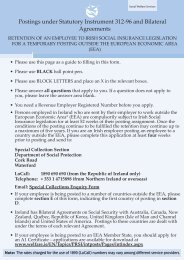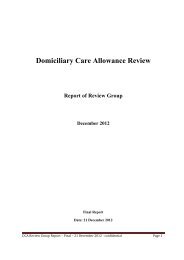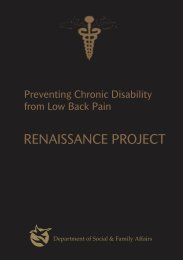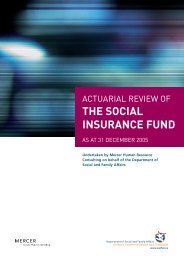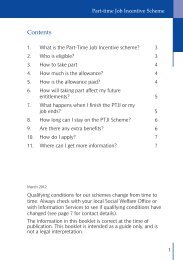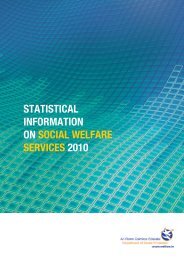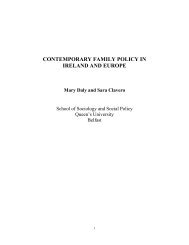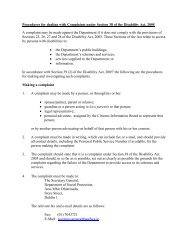Developing a Fully Inclusive Social Insurance Model - Welfare.ie
Developing a Fully Inclusive Social Insurance Model - Welfare.ie
Developing a Fully Inclusive Social Insurance Model - Welfare.ie
You also want an ePaper? Increase the reach of your titles
YUMPU automatically turns print PDFs into web optimized ePapers that Google loves.
can have an effect on employment. The arguments mirror those of the Commission on Taxation (1982)which concluded, with one member dissenting, that “compulsory social insurance contributions are moreappropriately regarded as a tax”, on the basis that they are a compulsory payment to Government andnot directly related to benefits received and that they are included in the classification of taxespublished by international bod<strong>ie</strong>s such as the IMF as well as in National Income Accounts; TheCommission recommended a single social security tax in place of social insurance contributions, to belev<strong>ie</strong>d on all income, at a single rate. This v<strong>ie</strong>w was not shared by the Commission on <strong>Social</strong> <strong>Welfare</strong>(1986); it regarded social insurance contributions as having a significant insurance dimension.Financing the social insurance systemThe system maintains a relationship between labour force status, earnings from work, contributionsmade and, finally, entitlement to benefits in the event of certain specif<strong>ie</strong>d contingenc<strong>ie</strong>s (such as illness,unemployment or old age). As with many social insurance systems throughout the world, the Irishsocial insurance system is based on the “Pay As You Go" principle, whereby current contributors fundthe pensions and benefits of present recip<strong>ie</strong>nts i.e. previous contributors, while also building upentitlement to their own future benefits, in turn paid for by future contributors.Contributions paid under Pay Related <strong>Social</strong> <strong>Insurance</strong> (PRSI) by employers, employees, the selfemployed and voluntary contributors are paid into the <strong>Social</strong> <strong>Insurance</strong> Fund (SIF) 1 . The Fund thenfinances the payment of social insurance payments such as short-term benefits and long-termpensions. The system is not strictly actuarially based insofar that there is no direct link at the individuallevel between contributions and potential benefits. However, the existence of a separate <strong>Social</strong><strong>Insurance</strong> Fund means that such a link can be made at the wider level given the nature of the SIF andPRSI contributions are earmarked for particular social insurance benefits. They are not generally used forpurposes other than payment of benefits and are therefore not the same as taxes, dut<strong>ie</strong>s or othercharges which are used to finance Exchequer expenditure generally. In recent years, the first actuarialrev<strong>ie</strong>w of the system was undertaken and such rev<strong>ie</strong>ws are required under social welfare legislationevery five years, so as to gauge the overall long-term sustainability and costs of the system,independently of the broader Government financial picture (Govt. of Ireland, 2002a).The SIF comprises a current account and an investment account. The Minister for <strong>Social</strong> and FamilyAffairs manages and controls the current account of the Fund while the Minister for Finance managesand controls the investment account. Benefits payments are paid from the current account. To theextent that annual income is not required for benefit payments, it is retained in the investment accountand this finance together with the accumulated surplus form previous years, is transferred to theinvestment account which is managed by the Minister for Finance (through the National TreasuryManagement Agency). Both the income arising from these investments and the capital is available forcurrent payments if and when required. The Comptroller and Auditor General has responsibility forauditing, on a yearly basis, the accounts of the SIF.Trends in income and expenditureTable 1.1 compares total social insurance expenditure with total social welfare expenditure over the pastnumber of years. From 1991 to 2003, social insurance expenditure increased by 251%; it now accountsfor almost 46% of total social welfare spending, or almost 55% excluding Child Benefit. The main reasonfor the increase was the rise in the real value of benefits, as well as an increase in the numbers ofpensioners and recip<strong>ie</strong>nts.1 While the Health Contribution and the Industrial Training (Apprenticeship) Levy are collected with PRSI, these mon<strong>ie</strong>s are not used for <strong>Social</strong><strong>Insurance</strong> purposes and have no connection with the SIF.DEVELOPING A FULLY INCLUSIVE SOCIAL INSURANCE MODEL3



